英语文学中得修辞手法
英语中常见的修辞手法
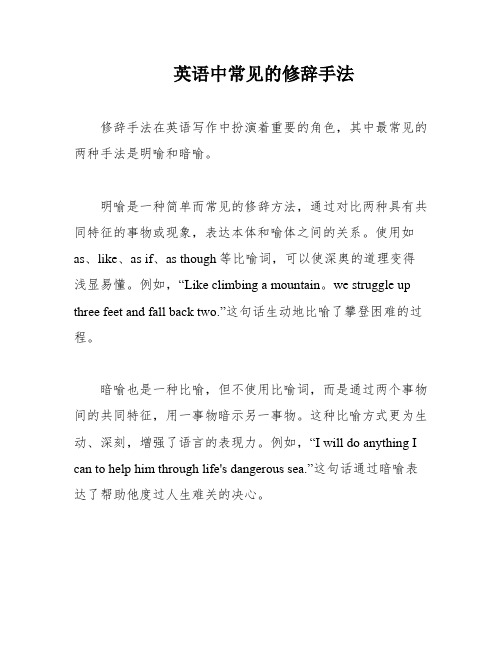
英语中常见的修辞手法修辞手法在英语写作中扮演着重要的角色,其中最常见的两种手法是明喻和暗喻。
明喻是一种简单而常见的修辞方法,通过对比两种具有共同特征的事物或现象,表达本体和喻体之间的关系。
使用如as、like、as if、as though等比喻词,可以使深奥的道理变得浅显易懂。
例如,“Like climbing a mountain。
we struggle up three feet and fall back two.”这句话生动地比喻了攀登困难的过程。
暗喻也是一种比喻,但不使用比喻词,而是通过两个事物间的共同特征,用一事物暗示另一事物。
这种比喻方式更为生动、深刻,增强了语言的表现力。
例如,“I will do anything I can to help him through life's dangerous sea.”这句话通过暗喻表达了帮助他度过人生难关的决心。
修辞手法可以使文章更加生动、形象,让读者更容易理解和记忆。
因此,在写作中灵活使用各种修辞手法,可以提高文章的质量和吸引力。
XXX XXX(将原文稍作改写,去除了夸张用语,更加客观地描述了XXX的作品)XXX。
For example。
on the first day of school。
beautiful XXX(将原文进行了简化和修辞,使句子更加生动有趣)XXX XXX XXX。
XXX(将原文进行了简化和修辞,使用了拟人化手法,使句子更加生动)Irony is the use of words to express the opposite of their literal meaning。
often used for sarcasm。
For example。
"What fine weather for an outing!" can be used to express XXX(将原文进行了简化和修辞,更加准确地描述了反语的用法和效果)头韵是英语中常见的修辞手法,它指的是连续数个单词的头音或头字母相同。
英语文学作品中修辞手法的应用探析

英语文学作品中修辞手法的应用探析英语文学作品对于大多数人来说,是一种艺术的魅力,其中的修辞让读者有一种亲近的感觉,使作品更具有感染力和吸引力。
修辞被定义为语言的艺术手法,通过增加文学作品的节奏、意象、冲击等特点,增加文学作品的艺术性、准确性和引人注目性。
英语文学作品中的修辞手法是语言表达艺术的重要组成部分,也是语言表达艺术实现者对文学思维内容的表达重要的手段。
本文旨在探讨英语文学作品中修辞手法的应用,指出修辞的种类,以及它们在作品中的运用情况,从而可以帮助读者从一个更深层次上理解作品的含义。
修辞手法是文学作品中语言手法的种类,可以划分为形式修辞和意义修辞,前者广泛应用于文学作品中,后者则是作品中更加抽象的表达形式,深刻地反映了故事情节。
形式修辞主要分为比喻、排比、拟人、借代、照应、反复,主要用于增强情绪效果,进一步深化读者对作品的理解。
比喻是比较两个不同的事物之间的相似之处,直接或间接地对比它们,以增加文章的热情和节奏;排比则是将相同的句子或者是句子结构连在一起,增加文章的强烈性;拟人则是把事物形容成人的动作,从而把本不能表达的感情表达出来;借代则是把其他物象比作另一个物象,从而使意象更加丰富、明确;照应则是将不相关的词语之间产生对应关系,使文章更加完整;反复则是指在文章中重复出现某一内容,以增加文章的感染力。
另一方面,意义修辞着重于作品中潜在的意义表达,主要分为暗喻、拟声、夸张和排他。
暗喻是指语言的隐喻,将一个抽象的概念或实体用一个具体的概念或实体来表示,这种形式的表达使文章有深刻的思想内涵;拟声是指用语言语音或非语音来抒发情感,比如尖叫、哭泣等;夸张是指运用语言法使表达内容更显突出,比如把一件事物描写得极端、戏剧性强烈;而排他则是运用对比的手法,使一方的特征显得更加凸现。
英语文学作品中的修辞手法对作品的感染力起着至关重要的作用,它们大大提高了文章的可读性和艺术性,使读者能够更好地理解作品的内涵,从而从作品中获得更多的智慧。
(完整word)20种英语修辞手法整理
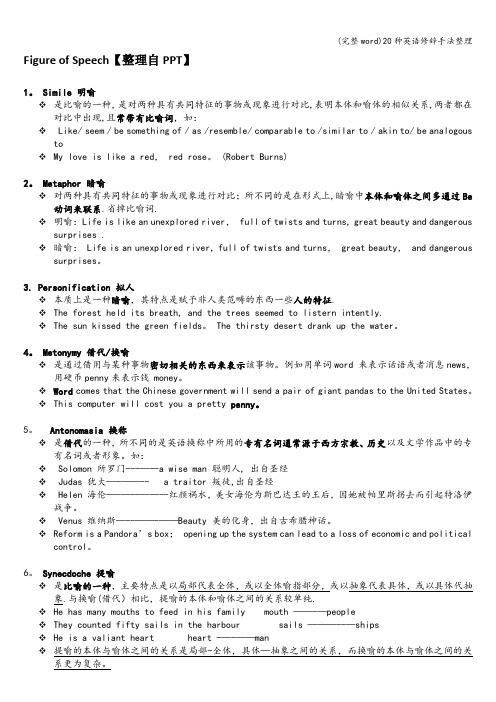
Figure of Speech【整理自PPT】1。
Simile 明喻❖是比喻的一种,是对两种具有共同特征的事物或现象进行对比,表明本体和喻体的相似关系,两者都在对比中出现,且常带有比喻词,如:❖ Like/ seem / be something of / as /resemble/ comparable to /similar to / akin to/ be analogous to❖My love is like a red, red rose。
(Robert Burns)2。
Metaphor 暗喻❖对两种具有共同特征的事物或现象进行对比;所不同的是在形式上,暗喻中本体和喻体之间多通过Be 动词来联系.省掉比喻词.❖明喻:Life is like an unexplored river, full of twists and turns, great beauty and dangerous surprises .❖暗喻: Life is an unexplored river, full of twists and turns, great beauty, and dangerous surprises。
3. Personification 拟人❖本质上是一种暗喻,其特点是赋予非人类范畴的东西一些人的特征.❖The forest held its breath, and the trees seemed to listern intently.❖The sun kissed the green fields。
The thirsty desert drank up the water。
4。
Metonymy 借代/换喻❖是通过借用与某种事物密切相关的东西来表示该事物。
例如用单词word 来表示话语或者消息news,用硬币penny来表示钱 money。
❖Word comes that the Chinese government will send a pair of giant pandas to the United States。
英语文学作品中的修辞赏析
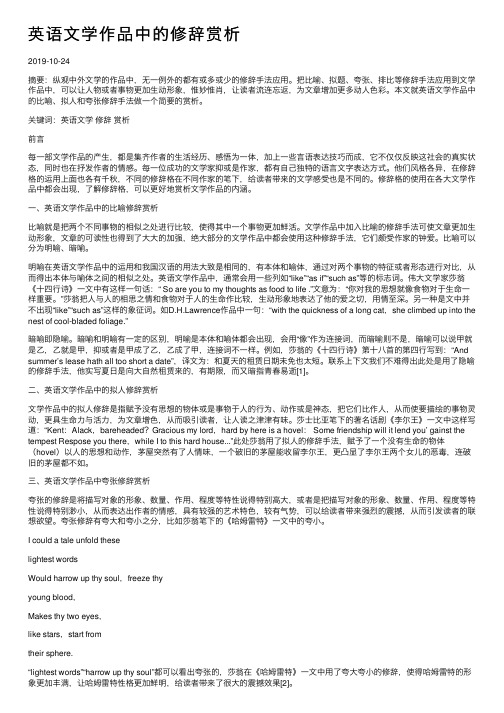
英语⽂学作品中的修辞赏析2019-10-24摘要:纵观中外⽂学的作品中,⽆⼀例外的都有或多或少的修辞⼿法应⽤。
把⽐喻、拟题、夸张、排⽐等修辞⼿法应⽤到⽂学作品中,可以让⼈物或者事物更加⽣动形象,惟妙惟肖,让读者流连忘返,为⽂章增加更多动⼈⾊彩。
本⽂就英语⽂学作品中的⽐喻、拟⼈和夸张修辞⼿法做⼀个简要的赏析。
关键词:英语⽂学修辞赏析前⾔每⼀部⽂学作品的产⽣,都是集齐作者的⽣活经历、感悟为⼀体,加上⼀些⾔语表达技巧⽽成,它不仅仅反映这社会的真实状态,同时也在抒发作者的情感。
每⼀位成功的⽂学家抑或是作家,都有⾃⼰独特的语⾔⽂字表达⽅式。
他们风格各异,在修辞格的运⽤上⾯也各有千秋,不同的修辞格在不同作家的笔下,给读者带来的⽂学感受也是不同的。
修辞格的使⽤在各⼤⽂学作品中都会出现,了解修辞格,可以更好地赏析⽂学作品的内涵。
⼀、英语⽂学作品中的⽐喻修辞赏析⽐喻就是把两个不同事物的相似之处进⾏⽐较,使得其中⼀个事物更加鲜活。
⽂学作品中加⼊⽐喻的修辞⼿法可使⽂章更加⽣动形象,⽂章的可读性也得到了⼤⼤的加强,绝⼤部分的⽂学作品中都会使⽤这种修辞⼿法,它们颇受作家的钟爱。
⽐喻可以分为明喻、暗喻。
明喻在英语⽂学作品中的运⽤和我国汉语的⽤法⼤致是相同的,有本体和喻体,通过对两个事物的特征或者形态进⾏对⽐,从⽽得出本体与喻体之间的相似之处。
英语⽂学作品中,通常会⽤⼀些列如“like”“as if”“such as”等的标志词。
伟⼤⽂学家莎翁《⼗四⾏诗》⼀⽂中有这样⼀句话:“ So are you to my thoughts as food to life .”⽂意为:“你对我的思想就像⾷物对于⽣命⼀样重要。
”莎翁把⼈与⼈的相思之情和⾷物对于⼈的⽣命作⽐较,⽣动形象地表达了他的爱之切,⽤情⾄深。
另⼀种是⽂中并不出现“like”“such as”这样的象征词。
如wrence作品中⼀句:“with the quickness of a long cat,she climbed up into the nest of cool-bladed foliage.”暗喻即隐喻。
英语常见8种修辞手法说明
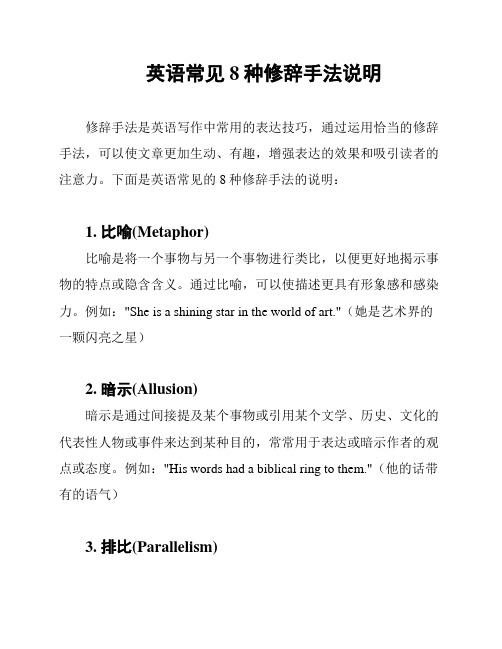
英语常见8种修辞手法说明修辞手法是英语写作中常用的表达技巧,通过运用恰当的修辞手法,可以使文章更加生动、有趣,增强表达的效果和吸引读者的注意力。
下面是英语常见的8种修辞手法的说明:1. 比喻(Metaphor)比喻是将一个事物与另一个事物进行类比,以便更好地揭示事物的特点或隐含含义。
通过比喻,可以使描述更具有形象感和感染力。
例如:"She is a shining star in the world of art."(她是艺术界的一颗闪亮之星)2. 暗示(Allusion)暗示是通过间接提及某个事物或引用某个文学、历史、文化的代表性人物或事件来达到某种目的,常常用于表达或暗示作者的观点或态度。
例如:"His words had a biblical ring to them."(他的话带有的语气)3. 排比(Parallelism)排比是通过重复使用类似的词、短语或句子结构,使文章的句子齐整有序,增强表达的力度和冲击力。
例如:"We came, we saw, we conquered." (我们来了,我们看到了,我们战胜了)4. 反问(Rhetorical Question)反问是在文章或演讲中提出一个问题,但并不期待对方回答,而是用问句来引导读者或听众思考某个问题或强调某个观点。
例如:"Isn't it a beautiful day?"(今天是不是个美好的一天呢?)5. 夸张(Hyperbole)夸张是通过夸大的描述方式来强调某个事物或情感,以达到增强效果的目的。
夸张常用于幽默、夸张或强调的场合。
例如:"I've told you a million times."(我已经告诉过你一百万次了)比较是通过将两个或多个事物进行对比,以突出它们的差异或相似之处,使表达更具有说服力和可信度。
英语文学的修辞手法

英语文学中常见的修辞手法包括:1. **明喻(Simile)**:明喻是将具有共性的不同事物作对比,这种共性存在于人们的心里,而不是事物的自然属性。
常用的比喻词有like、as、seem、as if、as though、similar to、such as等。
例如,“他就像公鸡一样,以为太阳因为要听他啼叫才升起。
”2. **隐喻(Metaphor)**:隐喻是简缩了的明喻,是将某一事物的名称用于另一事物,通过比较形成。
例如,“爱因斯坦只盖着一条毯子,好像他刚走出童话故事一样。
”3. **借喻(Metonymy)**:借喻不直接说出所要说的事物,而使用另一个与之相关的事物名称。
例如,用“白宫”代表美国政府。
4. **提喻(Synecdoche)**:提喻是用部分代替全体,或用全体代替部分,或特殊代替一般。
例如,“一辆汽车开过去了”中的“汽车”代表车辆的全部,这是用部分代替整体。
5. **通感(Synaesthesia)**:通感就是把不同感官的感觉沟通起来,借联想引起感觉转移,“以感觉写感觉”。
例如,“Taste the music of Mozart.”(品尝Mozart的音乐)。
6. **拟人(Personification)**:拟人是把生命赋予无生命的事物。
例如,“The night gently closed the petals of the flowers.”(夜晚轻轻地合上花瓣。
)7. **夸张(Hyperbole)**:夸张是以言过其实的说法表达强调的目的。
例如,“She talked my ears off.”(她把我耳朵都说麻了。
)这些修辞手法在英语文学中被广泛使用,可以帮助作者更生动、形象地表达自己的想法和感受。
emotive language英文修辞
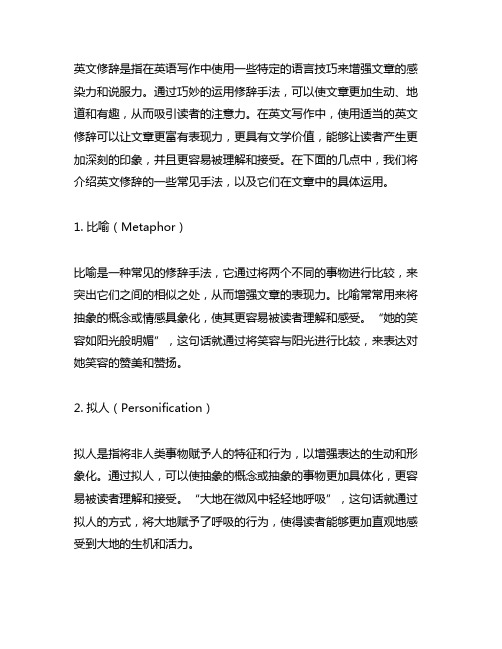
英文修辞是指在英语写作中使用一些特定的语言技巧来增强文章的感染力和说服力。
通过巧妙的运用修辞手法,可以使文章更加生动、地道和有趣,从而吸引读者的注意力。
在英文写作中,使用适当的英文修辞可以让文章更富有表现力,更具有文学价值,能够让读者产生更加深刻的印象,并且更容易被理解和接受。
在下面的几点中,我们将介绍英文修辞的一些常见手法,以及它们在文章中的具体运用。
1. 比喻(Metaphor)比喻是一种常见的修辞手法,它通过将两个不同的事物进行比较,来突出它们之间的相似之处,从而增强文章的表现力。
比喻常常用来将抽象的概念或情感具象化,使其更容易被读者理解和感受。
“她的笑容如阳光般明媚”,这句话就通过将笑容与阳光进行比较,来表达对她笑容的赞美和赞扬。
2. 拟人(Personification)拟人是指将非人类事物赋予人的特征和行为,以增强表达的生动和形象化。
通过拟人,可以使抽象的概念或抽象的事物更加具体化,更容易被读者理解和接受。
“大地在微风中轻轻地呼吸”,这句话就通过拟人的方式,将大地赋予了呼吸的行为,使得读者能够更加直观地感受到大地的生机和活力。
3. 排比(Parallelism)排比是一种修辞手法,通过重复使用相同的句式或结构,来增强文章的节奏感和说服力。
排比可以使文章更加流畅和易读,同时也能够增强文章的表现力和感染力。
“我不会畏惧困难,我不会退缩,我会勇往直前”,这句话就通过排比的方式,将相似结构的短语进行重复,来表达作者坚定的决心和信念。
4. 借代(Metonymy)借代是一种常见的修辞手法,通过用一个与被表示的对象有密切关系的词来代指该对象,以增强文章的表现力和表达的准确性。
借代可以使文章更加简练和生动,同时也能够使文章更加富有文学气息和艺术感。
“政府宣布了新政策”,这句话中的“政府”就是借代,用来代指政府发布新政策的行为。
5. 比较(Simile)比较是一种常见的修辞手法,通过使用“像”、“如同”等词语将两个不同的事物进行比较,来突出它们之间的相似之处。
英语18种重要修辞手法
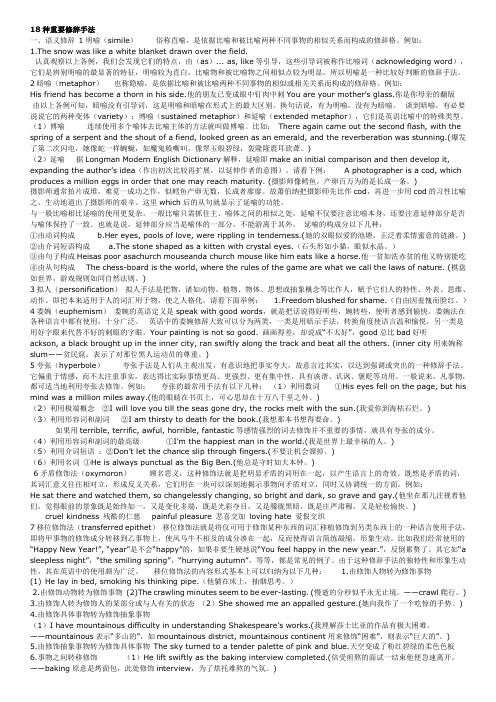
18种重要修辞手法一、语义修辞1明喻(simile)俗称直喻,是依据比喻和被比喻两种不同事物的相似关系而构成的修辞格。
例如:1.The snow was like a white blanket drawn over the field.认真观察以上各例,我们会发现它们的特点,由(as)... as, like等引导,这些引导词被称作比喻词(acknowledging word),它们是辨别明喻的最显著的特征,明喻较为直白,比喻物和被比喻物之间相似点较为明显,所以明喻是一种比较好判断的修辞手法。
2暗喻(metaphor)也称隐喻,是依据比喻和被比喻两种不同事物的相似或相关关系而构成的修辞格。
例如:His friend has become a thorn in his side.他的朋友已变成眼中钉肉中刺You are your mother’s glass.你是你母亲的翻版由以上各例可知,暗喻没有引导词,这是明喻和暗喻在形式上的最大区别。
换句话说,有为明喻,没有为暗喻。
谈到暗喻,有必要说说它的两种变体(variety):博喻(sustained metaphor)和延喻(extended metaphor),它们是英语比喻中的特殊类型。
(1)博喻连续使用多个喻体去比喻主体的方法就叫做博喻。
比如:There again came out the second flash, with the spring of a serpent and the shout of a fiend, looked green as an emerald, and the reverberation was stunning.(爆发了第二次闪电,她像蛇一样蜿蜒,如魔鬼般嘶叫,像翠玉般碧绿,轰隆隆震耳欲聋。
)(2)延喻据Longman Modern English Dictionary解释,延喻即make an initial comparison and then develop it, expanding the author’s idea(作出初次比较再扩展,以延伸作者的意图)。
英语文学中得修辞手法
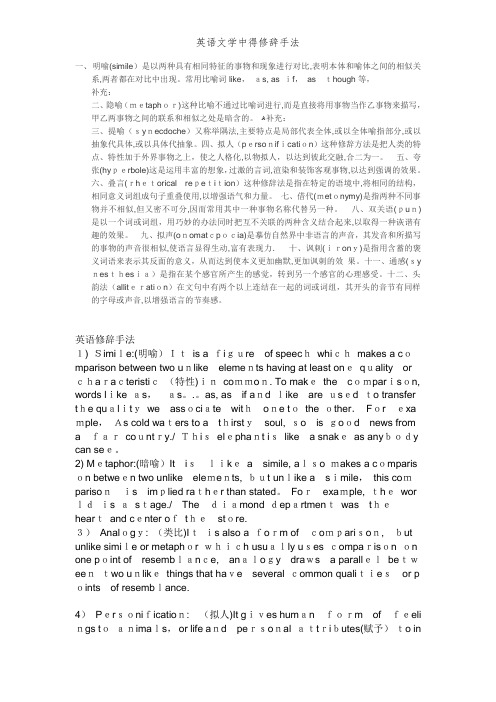
一、明喻(simile)是以两种具有相同特征的事物和现象进行对比,表明本体和喻体之间的相似关系,两者都在对比中出现。
常用比喻词like,as, as if,asthough等,补充:二、隐喻(metaphor)这种比喻不通过比喻词进行,而是直接将用事物当作乙事物来描写,甲乙两事物之间的联系和相似之处是暗含的。
ﻫ补充:三、提喻(synecdoche)又称举隅法,主要特点是局部代表全体,或以全体喻指部分,或以抽象代具体,或以具体代抽象。
四、拟人(personification)这种修辞方法是把人类的特点、特性加于外界事物之上,使之人格化,以物拟人,以达到彼此交融,合二为一。
五、夸张(hyperbole)这是运用丰富的想象,过激的言词,渲染和装饰客观事物,以达到强调的效果。
六、叠言(rhetorical repetition)这种修辞法是指在特定的语境中,将相同的结构,相同意义词组成句子重叠使用,以增强语气和力量。
七、借代(metonymy)是指两种不同事物并不相似,但又密不可分,因而常用其中一种事物名称代替另一种。
八、双关语(pun)是以一个词或词组,用巧妙的办法同时把互不关联的两种含义结合起来,以取得一种诙谐有趣的效果。
九、拟声(onomatcpocia)是摹仿自然界中非语言的声音,其发音和所描写的事物的声音很相似,使语言显得生动,富有表现力.十、讽刺(irony)是指用含蓄的褒义词语来表示其反面的意义,从而达到使本义更加幽默,更加讽刺的效果。
十一、通感(sy nesthesia)是指在某个感官所产生的感觉,转到另一个感官的心理感受。
十二、头韵法(alliteration)在文句中有两个以上连结在一起的词或词组,其开头的音节有同样的字母或声音,以增强语言的节奏感。
英语修辞手法1) Simile:(明喻)Itis a figure of speechwhichmakes a comparison between two unlike elements having at least onequality orcharacteristic(特性)incommon. To makethe comparison, words like as,as。
英语中的修辞手法

英语中的修辞手法Figures of speechSimile(明喻)句型(1).like型Eg: Living without an aim is like sailing without a compass.生活没有目标犹如航行没有指南针They will never be able to save money to buy a new house——they both spend money like water.★as 型英语里有不少含有明喻的成语,其结构为as+形容词+as+名词(第一个as可省略)。
例如:(as) firm as a rock 坚如磐石(as) light as a feather 轻如鸿毛(as) close as an oyster 守口如瓶(as) strong as a horse 强壮如牛(as) cool as a cucumber 泰然自若★虚拟句型最常见的是as if/though,另外还有其他一些形式。
He woke them both up getting to bed, but when they tried to wake him up afterwards they might as well have tried to wake the dead.他去睡觉的时候把他们两个都弄醒了,但是后来他们想唤醒他时,简直就像唤死人一样。
★what型A. A is to B what X is to YEg: Reading is to the mind what exercise is to the body.阅读之于思想,如同锻炼之于身体。
Judicious praise is to children what the sun is to flowers.明智的表扬对于孩子的作用,就像阳光对于花朵的作用。
B What X is to Y, A is to B.Eg: What salt is to food, that wit and humour are to conversation and literature.妙语与幽默对于会话与文学,恰似盐对于食物一样。
英语文学作品中修辞手法论文
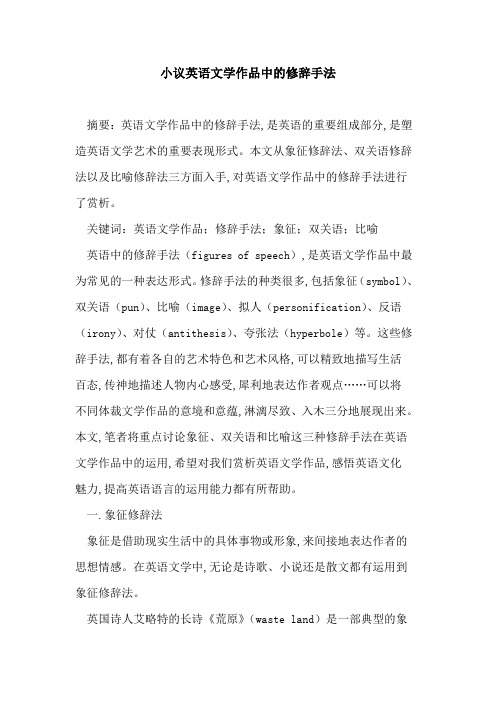
小议英语文学作品中的修辞手法摘要:英语文学作品中的修辞手法,是英语的重要组成部分,是塑造英语文学艺术的重要表现形式。
本文从象征修辞法、双关语修辞法以及比喻修辞法三方面入手,对英语文学作品中的修辞手法进行了赏析。
关键词:英语文学作品;修辞手法;象征;双关语;比喻英语中的修辞手法(figures of speech),是英语文学作品中最为常见的一种表达形式。
修辞手法的种类很多,包括象征(symbol)、双关语(pun)、比喻(image)、拟人(personification)、反语(irony)、对仗(antithesis)、夸张法(hyperbole)等。
这些修辞手法,都有着各自的艺术特色和艺术风格,可以精致地描写生活百态,传神地描述人物内心感受,犀利地表达作者观点……可以将不同体裁文学作品的意境和意蕴,淋漓尽致、入木三分地展现出来。
本文,笔者将重点讨论象征、双关语和比喻这三种修辞手法在英语文学作品中的运用,希望对我们赏析英语文学作品,感悟英语文化魅力,提高英语语言的运用能力都有所帮助。
一.象征修辞法象征是借助现实生活中的具体事物或形象,来间接地表达作者的思想情感。
在英语文学中,无论是诗歌、小说还是散文都有运用到象征修辞法。
英国诗人艾略特的长诗《荒原》(waste land)是一部典型的象征主义作品。
这部作品中,作者描写了大量的典故、语言、神话,用以象征现代社会中的“荒原人”形象,从而深刻地批判了当时腐败的西方资本主义文明。
第一部分“死者的葬仪”中就运用了大量象征手法。
“april is the cruellest month, breeding ……what are the roots that clutch, what branches growout of this stony rubbish? son of man……a heap of broken images, where the sun beatsand the dead tree gives no shelter, the cricket no relief and the dry stone no sound of water. only ……i will show you fear in a handful of dust.”诗人用用“破碎、拍击、没有阴凉、不使人轻松、恐惧”这一系列消极的词汇,来描写“树杈、乱石、枯树、蟋蟀、干石头……”这些具体的、狼狈不堪的事物。
英语语言文学的常见修辞手法的应用

英语语言文学的常见修辞手法的应用
1. 比喻:将两种事物进行比较,以强调它们的相似之处,例如:时间如流水般匆匆。
2. 拟人:将非人物赋予人的特质,如“风”“呼啸着”,“大地”“颤抖着”。
3. 重复:重复同一个词或短语以加强语感和表现力,例如:天上的星星闪闪发光。
4. 排比:使用同样结构的短语或句子进行排列,例如:早上起床,刷牙洗脸,吃
早餐。
5. 倍音:在一个词或短语中,将相同或相似的音节重复使用,例如:咯咯笑声。
6. 借代:用一个代词或符号代替一个事物或概念,例如:万紫千红的鲜花,寓意
春天的到来。
7. 夸张:夸大事物的程度,使语言更加生动有趣,例如:我饿得能吞下一头牛。
8. 反问:用一个与答案相当明显的问题来掩饰自己的意图,例如:“难道不应该
付出努力吗?”
这些修辞手法可以使文学语言更富有感染力,生动独特,在英语文学中被广泛运用。
英语中的叙事技巧与文学手法知识点

英语中的叙事技巧与文学手法知识点英语是一门丰富多样的语言,它包含了许多叙事技巧和文学手法。
在英语写作中,熟练运用这些技巧和手法能够帮助我们更好地表达自己的意思,使文章更具有吸引力和说服力。
本文将介绍几个英语中常用的叙事技巧和文学手法知识点。
一、动词的运用动词是英语中最基本的句子成分之一,它起着描述、叙述情节的作用。
在叙事中,我们可以通过准确选择动词来刻画人物形象、描述场景和展开情节。
例如,使用具体、形象的动词可以使叙事更具生动感,如“sprint”表示短跑,“whisper”表示低声说话等。
同时,巧妙使用动词的时态和语态也可以增加叙事的张力和吸引力。
二、比喻和隐喻比喻和隐喻是英语中常用的修辞手法,通过将一个事物与另一个事物进行类比或暗示,使得叙事更富有想象力和感染力。
比喻是直接的明喻,如“她是一朵盛开的花”;而隐喻则是间接的暗示,如“他的咆哮像一头被惊扰的狮子”。
通过使用比喻和隐喻,我们可以为叙事增添色彩和情感。
三、对话的运用对话是叙事中常用的手法之一,它可以展现人物之间的互动和情感交流。
合理运用对话可以使叙事更加生动、有张力。
在对话中,需要注意人物的语言特点、语气以及一些细微的动作描写。
此外,适当穿插人物的内心独白也是一种增强叙事效果的手段。
四、承接词和过渡词的运用承接词和过渡词在英语写作中起到连接和过渡的作用,使得句子和段落之间更加连贯流畅。
这些词语包括但不限于:therefore, however, furthermore, in addition, on the other hand等。
通过使用这些词语,我们可以将叙事中不同的段落、不同的观点有机地连接在一起,使得文章结构更加清晰。
五、悬念的设置在叙事中,设置悬念能够吸引读者的兴趣,让他们愿意继续往下阅读。
悬念可以通过暂时性的停顿、信息的隐藏和情节的反转等方式来实现。
合理设置悬念有助于增加叙事的紧张感和吸引力,让读者产生持续的好奇心和阅读欲望。
英语13种修辞手法
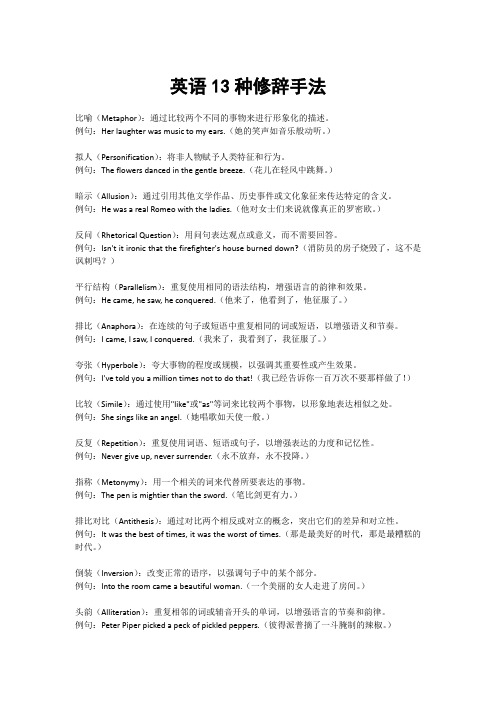
英语13种修辞手法比喻(Metaphor):通过比较两个不同的事物来进行形象化的描述。
例句:Her laughter was music to my ears.(她的笑声如音乐般动听。
)拟人(Personification):将非人物赋予人类特征和行为。
例句:The flowers danced in the gentle breeze.(花儿在轻风中跳舞。
)暗示(Allusion):通过引用其他文学作品、历史事件或文化象征来传达特定的含义。
例句:He was a real Romeo with the ladies.(他对女士们来说就像真正的罗密欧。
)反问(Rhetorical Question):用问句表达观点或意义,而不需要回答。
例句:Isn't it ironic that the firefighter's house burned down?(消防员的房子烧毁了,这不是讽刺吗?)平行结构(Parallelism):重复使用相同的语法结构,增强语言的韵律和效果。
例句:He came, he saw, he conquered.(他来了,他看到了,他征服了。
)排比(Anaphora):在连续的句子或短语中重复相同的词或短语,以增强语义和节奏。
例句:I came, I saw, I conquered.(我来了,我看到了,我征服了。
)夸张(Hyperbole):夸大事物的程度或规模,以强调其重要性或产生效果。
例句:I've told you a million times not to do that!(我已经告诉你一百万次不要那样做了!)比较(Simile):通过使用"like"或"as"等词来比较两个事物,以形象地表达相似之处。
例句:She sings like an angel.(她唱歌如天使一般。
)反复(Repetition):重复使用词语、短语或句子,以增强表达的力度和记忆性。
英语文学中得修辞手法
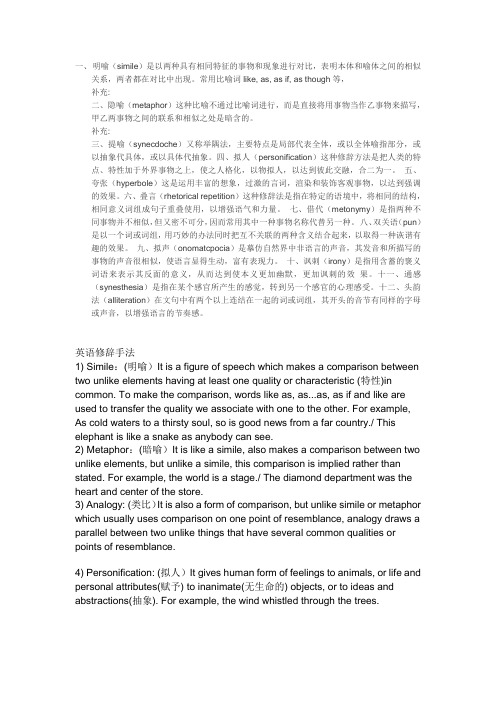
一、明喻(simile)是以两种具有相同特征的事物和现象进行对比,表明本体和喻体之间的相似关系,两者都在对比中出现。
常用比喻词like, as, as if, as though等,补充:二、隐喻(metaphor)这种比喻不通过比喻词进行,而是直接将用事物当作乙事物来描写,甲乙两事物之间的联系和相似之处是暗含的。
补充:三、提喻(synecdoche)又称举隅法,主要特点是局部代表全体,或以全体喻指部分,或以抽象代具体,或以具体代抽象。
四、拟人(personification)这种修辞方法是把人类的特点、特性加于外界事物之上,使之人格化,以物拟人,以达到彼此交融,合二为一。
五、夸张(hyperbole)这是运用丰富的想象,过激的言词,渲染和装饰客观事物,以达到强调的效果。
六、叠言(rhetorical repetition)这种修辞法是指在特定的语境中,将相同的结构,相同意义词组成句子重叠使用,以增强语气和力量。
七、借代(metonymy)是指两种不同事物并不相似,但又密不可分,因而常用其中一种事物名称代替另一种。
八、双关语(pun)是以一个词或词组,用巧妙的办法同时把互不关联的两种含义结合起来,以取得一种诙谐有趣的效果。
九、拟声(onomatcpocia)是摹仿自然界中非语言的声音,其发音和所描写的事物的声音很相似,使语言显得生动,富有表现力。
十、讽刺(irony)是指用含蓄的褒义词语来表示其反面的意义,从而达到使本义更加幽默,更加讽刺的效果。
十一、通感(synesthesia)是指在某个感官所产生的感觉,转到另一个感官的心理感受。
十二、头韵法(alliteration)在文句中有两个以上连结在一起的词或词组,其开头的音节有同样的字母或声音,以增强语言的节奏感。
英语修辞手法1) Simile:(明喻)It is a figure of speech which makes a comparison between two unlike elements having at least one quality or characteristic (特性)in common. To make the comparison, words like as, as...as, as if and like are used to transfer the quality we associate with one to the other. For example, As cold waters to a thirsty soul, so is good news from a far country./ This elephant is like a snake as anybody can see.2) Metaphor:(暗喻)It is like a simile, also makes a comparison between two unlike elements, but unlike a simile, this comparison is implied rather than stated. For example, the world is a stage./ The diamond department was the heart and center of the store.3) Analogy: (类比)It is also a form of comparison, but unlike simile or metaphor which usually uses comparison on one point of resemblance, analogy draws a parallel between two unlike things that have several common qualities or points of resemblance.4) Personification: (拟人)It gives human form of feelings to animals, or life and personal attributes(赋予) to inanimate(无生命的) objects, or to ideas and abstractions(抽象). For example, the wind whistled through the trees.5) Hyperbole: (夸张)It is the deliberate use of overstatement or exaggeration to achieve emphasis. For instance, he almost died laughing.6) Understatement: (含蓄陈述)It is the opposite of hyperbole, or overstatement. It achieves its effect of emphasizing a fact by deliberately(故意地) understating it, impressing the listener or the reader more by what is merely implied or left unsaid than by bare statement. For instance, It is no laughing matter.7) Euphemism: (委婉)It is the substitution of an agreeable or inoffensive(无冒犯) expression for one that may offend or suggest something unpleasant. For instance, we refer to "die" as” pass away".8) Metonymy (转喻)It is a figure of speech that has to do with the substitution of the mane of one thing for that of another. For instance, the pen (words) is mightier than the sword (forces). 借代(metonymy)是指两种不同事物并不相似,但又密不可分,因而常用其中一种事物名称代替另一种。
外语文学翻译中的修辞手法如何运用

外语文学翻译中的修辞手法如何运用在跨语言的文学交流中,外语文学翻译扮演着至关重要的角色。
它不仅仅是语言的转换,更是文化的传递、情感的共鸣和艺术的再现。
而修辞手法的运用,就如同翻译中的璀璨明珠,为文本增添了无尽的魅力和深度。
修辞手法是作者用来增强表达效果、使语言更加生动、形象、富有感染力的工具。
在外语文学作品中,修辞手法常常被巧妙地运用,以营造独特的氛围、塑造鲜明的人物形象、传达深刻的思想。
然而,将这些修辞手法准确而又自然地翻译到目标语言中,却是一项充满挑战的任务。
首先,我们需要理解原文中修辞手法的含义和作用。
这要求译者具备深厚的语言功底和文学素养,能够敏锐地捕捉到作者运用修辞手法的意图。
比如,在英语文学中,常见的修辞手法有比喻(metaphor)、拟人(personification)、夸张(hyperbole)、排比(parallelism)等。
以比喻为例,“Her eyes were stars shining in the night sky” (她的眼睛像夜空中闪烁的星星。
)译者需要理解这个比喻所传达的是女子眼睛的明亮和美丽,然后在目标语言中找到合适的表达方式,如“她的眼睛宛如夜空中璀璨的星星。
”在翻译修辞手法时,保持其效果的对等是关键。
但由于不同语言的文化背景和表达习惯存在差异,有时无法做到完全的形式对等。
这时,译者需要灵活运用各种策略,以实现功能对等。
比如,对于某些文化特定的修辞手法,可能需要进行适当的转换或解释。
一个典型的例子是英语中的“as American as apple pie”(像苹果派一样具有美国特色),如果直接翻译成目标语言,可能会让读者感到困惑。
这时,可以根据目标语言的文化背景,转换为类似“像饺子一样具有中国特色”这样的表达,以让读者能够理解其含义。
另外,译者还需要考虑目标语言读者的接受能力和审美习惯。
如果过于追求保留原文的修辞手法,可能会导致译文晦涩难懂。
比如,在翻译一些复杂的隐喻时,如果直译会让读者难以理解,不妨采用意译的方法,将其核心意思清晰地传达出来。
英语课程中的文学分析术语与词汇
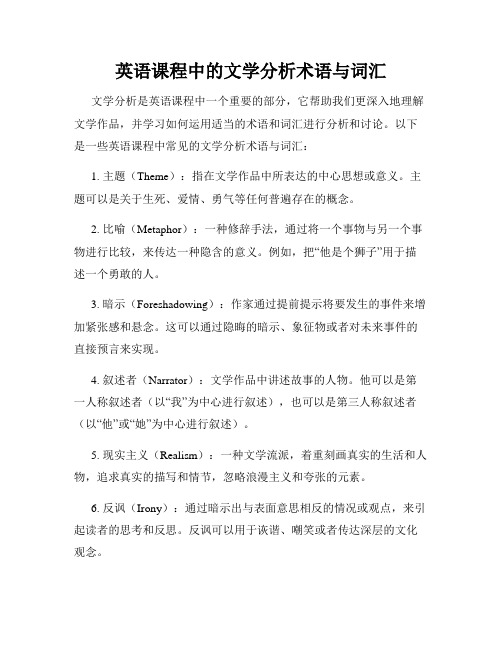
英语课程中的文学分析术语与词汇文学分析是英语课程中一个重要的部分,它帮助我们更深入地理解文学作品,并学习如何运用适当的术语和词汇进行分析和讨论。
以下是一些英语课程中常见的文学分析术语与词汇:1. 主题(Theme):指在文学作品中所表达的中心思想或意义。
主题可以是关于生死、爱情、勇气等任何普遍存在的概念。
2. 比喻(Metaphor):一种修辞手法,通过将一个事物与另一个事物进行比较,来传达一种隐含的意义。
例如,把“他是个狮子”用于描述一个勇敢的人。
3. 暗示(Foreshadowing):作家通过提前提示将要发生的事件来增加紧张感和悬念。
这可以通过隐晦的暗示、象征物或者对未来事件的直接预言来实现。
4. 叙述者(Narrator):文学作品中讲述故事的人物。
他可以是第一人称叙述者(以“我”为中心进行叙述),也可以是第三人称叙述者(以“他”或“她”为中心进行叙述)。
5. 现实主义(Realism):一种文学流派,着重刻画真实的生活和人物,追求真实的描写和情节,忽略浪漫主义和夸张的元素。
6. 反讽(Irony):通过暗示出与表面意思相反的情况或观点,来引起读者的思考和反思。
反讽可以用于诙谐、嘲笑或者传达深层的文化观念。
7. 隐喻(Simile):一种修辞手法,通过将一个事物与另一个事物进行比较,使用“像”或“如同”等词语来表示相似之处。
例如,“勇敢如同一只狮子”。
8. 普遍性(Universality):文学作品具有超越时间和地域限制的普遍价值和共鸣,能够触及读者的情感和思考。
9. 冲突(Conflict):故事中的核心问题或争议。
冲突可以是内部的(例如心理斗争)或外部的(例如社会压力)。
10. 符号(Symbol):一种具有特定含义的事物、人物或者场景,代表着更深层次的意义。
例如,白色通常象征和平和纯洁。
以上只是英语课程中常见的一些文学分析术语与词汇,通过学习和理解这些概念,我们可以更全面地阅读和欣赏文学作品。
英语中有19种修辞手法及英国文学作品与作家
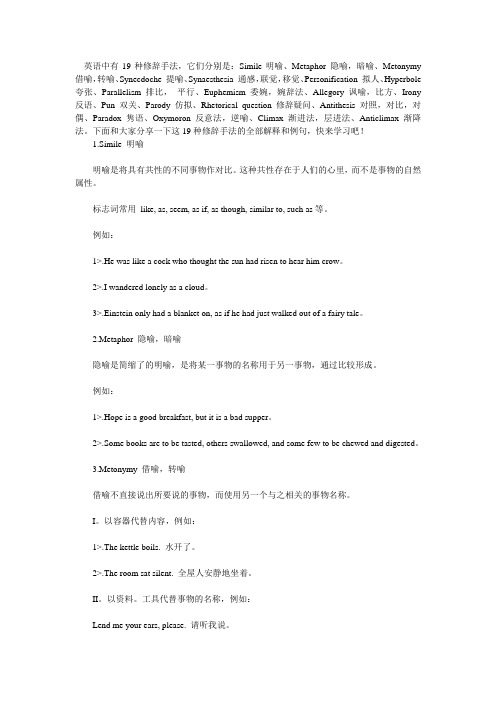
英语中有19种修辞手法,它们分别是:Simile明喻、Metaphor 隐喻,暗喻、Metonymy 借喻,转喻、Synecdoche 提喻、Synaesthesia 通感,联觉,移觉、Personification 拟人、Hyperbole 夸张、Parallelism 排比,平行、Euphemism 委婉,婉辞法、Allegory 讽喻,比方、Irony 反语、Pun 双关、Parody 仿拟、Rhetorical question 修辞疑问、Antithesis 对照,对比,对偶、Paradox 隽语、Oxymoron 反意法,逆喻、Climax 渐进法,层进法、Anticlimax 渐降法。
下面和大家分享一下这19种修辞手法的全部解释和例句,快来学习吧!1.Simile 明喻明喻是将具有共性的不同事物作对比。
这种共性存在于人们的心里,而不是事物的自然属性。
标志词常用like, as, seem, as if, as though, similar to, such as等。
例如:1>.He was like a cock who thought the sun had risen to hear him crow。
2>.I wandered lonely as a cloud。
3>.Einstein only had a blanket on, as if he had just walked out of a fairy tale。
2.Metaphor 隐喻,暗喻隐喻是简缩了的明喻,是将某一事物的名称用于另一事物,通过比较形成。
例如:1>.Hope is a good breakfast, but it is a bad supper。
2>.Some books are to be tasted, others swallowed, and some few to be chewed and digested。
英语30种修辞手法
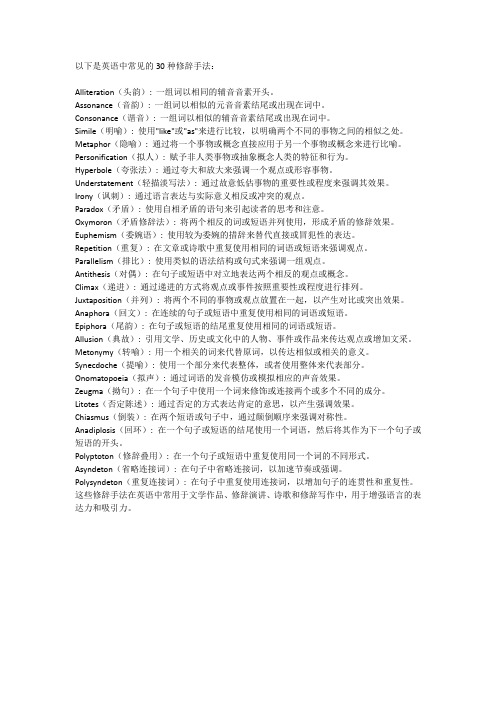
以下是英语中常见的30种修辞手法:Alliteration(头韵): 一组词以相同的辅音音素开头。
Assonance(音韵): 一组词以相似的元音音素结尾或出现在词中。
Consonance(谐音): 一组词以相似的辅音音素结尾或出现在词中。
Simile(明喻): 使用"like"或"as"来进行比较,以明确两个不同的事物之间的相似之处。
Metaphor(隐喻): 通过将一个事物或概念直接应用于另一个事物或概念来进行比喻。
Personification(拟人): 赋予非人类事物或抽象概念人类的特征和行为。
Hyperbole(夸张法): 通过夸大和放大来强调一个观点或形容事物。
Understatement(轻描淡写法): 通过故意低估事物的重要性或程度来强调其效果。
Irony(讽刺): 通过语言表达与实际意义相反或冲突的观点。
Paradox(矛盾): 使用自相矛盾的语句来引起读者的思考和注意。
Oxymoron(矛盾修辞法): 将两个相反的词或短语并列使用,形成矛盾的修辞效果。
Euphemism(委婉语): 使用较为委婉的措辞来替代直接或冒犯性的表达。
Repetition(重复): 在文章或诗歌中重复使用相同的词语或短语来强调观点。
Parallelism(排比): 使用类似的语法结构或句式来强调一组观点。
Antithesis(对偶): 在句子或短语中对立地表达两个相反的观点或概念。
Climax(递进): 通过递进的方式将观点或事件按照重要性或程度进行排列。
Juxtaposition(并列): 将两个不同的事物或观点放置在一起,以产生对比或突出效果。
Anaphora(回文): 在连续的句子或短语中重复使用相同的词语或短语。
Epiphora(尾韵): 在句子或短语的结尾重复使用相同的词语或短语。
Allusion(典故): 引用文学、历史或文化中的人物、事件或作品来传达观点或增加文采。
高一英语文学作品中的修辞手法分析单选题60题(答案解析)
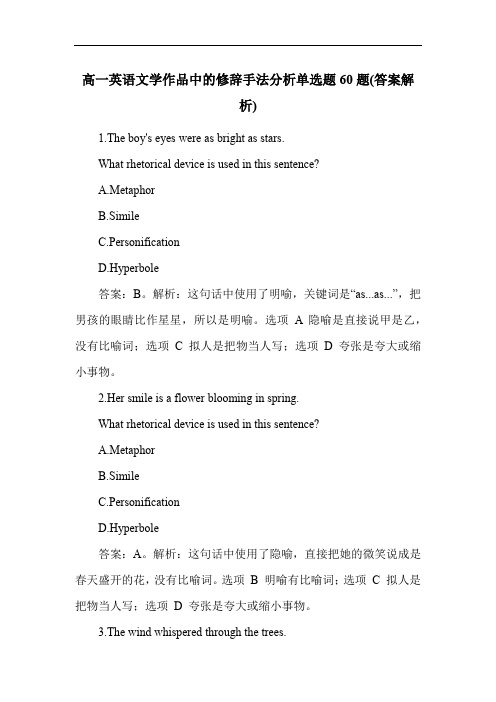
高一英语文学作品中的修辞手法分析单选题60题(答案解析)1.The boy's eyes were as bright as stars.What rhetorical device is used in this sentence?A.MetaphorB.SimileC.PersonificationD.Hyperbole答案:B。
解析:这句话中使用了明喻,关键词是“as...as...”,把男孩的眼睛比作星星,所以是明喻。
选项 A 隐喻是直接说甲是乙,没有比喻词;选项 C 拟人是把物当人写;选项 D 夸张是夸大或缩小事物。
2.Her smile is a flower blooming in spring.What rhetorical device is used in this sentence?A.MetaphorB.SimileC.PersonificationD.Hyperbole答案:A。
解析:这句话中使用了隐喻,直接把她的微笑说成是春天盛开的花,没有比喻词。
选项B 明喻有比喻词;选项C 拟人是把物当人写;选项D 夸张是夸大或缩小事物。
3.The wind whispered through the trees.What rhetorical device is used in this sentence?A.MetaphorB.SimileC.PersonificationD.Hyperbole答案:C。
解析:这句话中使用了拟人,把风当作人来写,会低语。
选项 A 隐喻是直接说甲是乙;选项 B 明喻有比喻词;选项 D 夸张是夸大或缩小事物。
4.His words were daggers piercing her heart.What rhetorical device is used in this sentence?A.MetaphorB.SimileC.PersonificationD.Hyperbole答案:A。
- 1、下载文档前请自行甄别文档内容的完整性,平台不提供额外的编辑、内容补充、找答案等附加服务。
- 2、"仅部分预览"的文档,不可在线预览部分如存在完整性等问题,可反馈申请退款(可完整预览的文档不适用该条件!)。
- 3、如文档侵犯您的权益,请联系客服反馈,我们会尽快为您处理(人工客服工作时间:9:00-18:30)。
一、明喻(simile)是以两种具有相同特征的事物和现象进行对比,表明本体和喻体之间的相似关系,两者都在对比中出现。
常用比喻词like, as, as if, as though等,补充:二、隐喻(metaphor)这种比喻不通过比喻词进行,而是直接将用事物当作乙事物来描写,甲乙两事物之间的联系和相似之处是暗含的。
补充:三、提喻(synecdoche)又称举隅法,主要特点是局部代表全体,或以全体喻指部分,或以抽象代具体,或以具体代抽象。
四、拟人(personification)这种修辞方法是把人类的特点、特性加于外界事物之上,使之人格化,以物拟人,以达到彼此交融,合二为一。
五、夸张(hyperbole)这是运用丰富的想象,过激的言词,渲染和装饰客观事物,以达到强调的效果。
六、叠言(rhetorical repetition)这种修辞法是指在特定的语境中,将相同的结构,相同意义词组成句子重叠使用,以增强语气和力量。
七、借代(metonymy)是指两种不同事物并不相似,但又密不可分,因而常用其中一种事物名称代替另一种。
八、双关语(pun)是以一个词或词组,用巧妙的办法同时把互不关联的两种含义结合起来,以取得一种诙谐有趣的效果。
九、拟声(onomatcpocia)是摹仿自然界中非语言的声音,其发音和所描写的事物的声音很相似,使语言显得生动,富有表现力。
十、讽刺(irony)是指用含蓄的褒义词语来表示其反面的意义,从而达到使本义更加幽默,更加讽刺的效果。
十一、通感(synesthesia)是指在某个感官所产生的感觉,转到另一个感官的心理感受。
十二、头韵法(alliteration)在文句中有两个以上连结在一起的词或词组,其开头的音节有同样的字母或声音,以增强语言的节奏感。
英语修辞手法1) Simile:(明喻)It is a figure of speech which makes a comparison between two unlike elements having at least one quality or characteristic (特性)in common. To make the comparison, words like as, as...as, as if and like are used to transfer the quality we associate with one to the other. For example, As cold waters to a thirsty soul, so is good news from a far country./ This elephant is like a snake as anybody can see.2) Metaphor:(暗喻)It is like a simile, also makes a comparison between two unlike elements, but unlike a simile, this comparison is implied rather than stated. For example, the world is a stage./ The diamond department was the heart and center of the store.3) Analogy: (类比)It is also a form of comparison, but unlike simile or metaphor which usually uses comparison on one point of resemblance, analogy draws a parallel between two unlike things that have several common qualities or points of resemblance.4) Personification: (拟人)It gives human form of feelings to animals, or life and personal attributes(赋予) to inanimate(无生命的) objects, or to ideas and abstractions(抽象). For example, the wind whistled through the trees.5) Hyperbole: (夸张)It is the deliberate use of overstatement or exaggeration to achieve emphasis. For instance, he almost died laughing.6) Understatement: (含蓄陈述)It is the opposite of hyperbole, or overstatement. It achieves its effect of emphasizing a fact by deliberately(故意地) understating it, impressing the listener or the reader more by what is merely implied or left unsaid than by bare statement. For instance, It is no laughing matter.7) Euphemism: (委婉)It is the substitution of an agreeable or inoffensive(无冒犯) expression for one that may offend or suggest something unpleasant. For instance, we refer to "die" as” pass away".8) Metonymy (转喻)It is a figure of speech that has to do with the substitution of the mane of one thing for that of another. For instance, the pen (words) is mightier than the sword (forces). 借代(metonymy)是指两种不同事物并不相似,但又密不可分,因而常用其中一种事物名称代替另一种。
1、Several years later, word came that Napoleonyh himself was coming to inspect them...几年以后,他们听说拿破仑要亲自来视察他们。
“word”在这里代替了“news, information”(消息、信息)2、Al spoke with his eyes,“yes”.艾尔用眼睛说,“是的”。
“说”应该是嘴的功能,这里实际上是用眼神表达了“说话的意思”。
9) Synecdoche (提喻)It is involves the substitution of the part for the whole, or the whole for the part. For instance, they say there's bread and work for all. She was dressed in silks.10) Antonomasia (换喻)It has also to do with substitution. It is not often mentioned now, though it is still in frequent use. For example, Solomon for a wise man. Daniel for a wise and fair judge. Judas for a traitor.11) Pun: (双关语)It is a play on words, or rather a play on the form and meaning of words. For instance, a cannon-ball took off his legs, so he laid down his arms. (Here "arms" has two meanings: a person's body; weapons carried by a soldier.)/ Napoleon was astonished.”Either you are mad, or I am,”he declared. “Both,sir!”cried the Swede proudly. “Both”一词一语双关,既指拿破仑和这位士兵都是疯子,又指这位战士参加过拿破仑指挥的两次战役12) Syllepsis: (一语双叙)It has two connotations.In the first case, it is a figure by which a word, or a particular form or inflection of a word, refers to two or more words in the same sentence, while properly applying to or agreeing with only on of them in grammar or syntax(句法). For example, He addressed you and me, and desired us to follow him. (Here us is used to refer to you and me.)In the second case, it a word may refer to two or more words in the same sentence. For example, while he was fighting , and losing limb and mind, and dying, others stayed behind to pursue education and career. (Here to losing one's limbs in literal; to lose one's mind is figurative, and means to go mad.)13) Zeugma: (轭式搭配)It is a single word which is made to modify or to govern two or more words in the same sentence, wither properly applying in sense to only one of them, or applying to them in different senses. For example, The sun shall not burn you by day, nor the moon by night. (Here noon is not strong enough to burn)14) Irony: (反语)It is a figure of speech that achieves emphasis by saying the opposite of what is meant, the intended meaning of the words being the opposite of their usual sense. For instance, we are lucky, what you said makes me feel real good.15) Innuendo: (暗讽)It is a mild form of irony, hinting in a rather roundabout (曲折)way at something disparaging(不一致) or uncomplimentary(不赞美) to the person or subject mentioned. For example, the weatherman said it would be worm. He must take his readings in a bathroom.16) Sarcasm: (讽刺)It Sarcasm is a strong form of irony. It attacks in a taunting and bitter manner, and its aim is to disparage, ridicule and wound the feelings of the subject attacked. For example, laws are like cobwebs, which may catch small flies, but let wasps break through.17) Paradox: (似非而是的隽语)It is a figure of speech consisting of a statement or proposition which on the face of it seems self-contradictory, absurd or contrary to established fact or practice, but which on further thinking and study may prove to be true, well-founded, and even to contain a succinct point. For example more haste, less speed.18) Oxymoron: (矛盾修饰)It is a compressed paradox, formed by the conjoining(结合) of two contrasting, contradictory or incongruous(不协调) terms as in bitter-sweet memories, orderly chaos(混乱) and proud humility(侮辱).19) Antithesis: (对照)It is the deliberate arrangement of contrasting words or ideas in balanced structural forms to achieve emphasis. For example, speech is silver; silence is golden.20) Epigram: (警句)It states a simple truth pithily(有利地) and pungently(强烈地). It is usually terse and arouses interest and surprise by its deep insight into certain aspects of human behavior or feeling. For instance, Few, save the poor, feel for the poor.21) Climax: (渐进)It is derived from the Greek word for "ladder" and implies the progression of thought at a uniform or almost uniform rate of significance or intensity, like the steps of a ladder ascending evenly. For example, I came, I saw, I conquered.22) Anti-climax or bathos: (突降)It is the opposite of Climax. It involves stating one's thoughts in a descending order of significance or intensity, from strong to weak, from weighty to light or frivolous. For instance, But thousands die, without or this or that, die, and endow(赋予) a college, or a cat.23) Apostrophe:(顿呼)In this figure of speech, a thing, place, idea or person (dead or absent) is addressed as if present, listening and understanding what is being said. For instance, England! awake! awake! awake!24) Transferred Epithet: (转类形容词)It is a figure of speech where an epithet (an adjective or descriptive phrase) is transferred from the noun it should rightly modify(修饰) to another to which it does not really apply or belong. For instance, I spent sleepless nights on my project.25) Alliteration: (头韵)It has to do with the sound rather than the sense of words for effect. It is a device that repeats the same sound at frequent intervals(间隔) and since the sound repeated is usually the initial consonant sound, it is also called "front rhyme". For instance, the fair breeze blew, the white foam flew, the furrow followed free. 头韵法(alliteration)在文句中有两个以上连结在一起的词或词组,其开头的音节有同样的字母或声音,以增强语言的节奏感。
